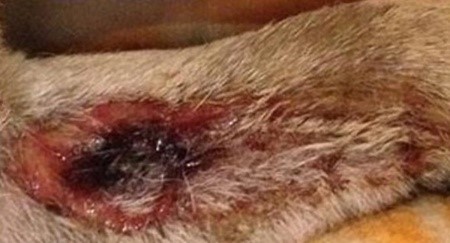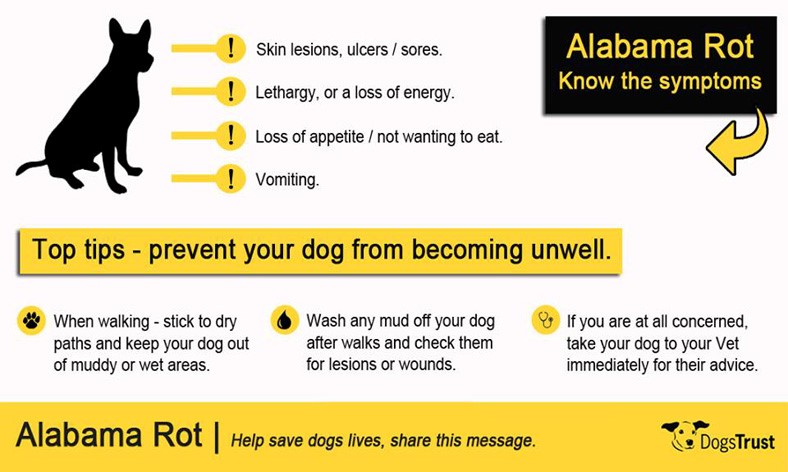ALABAMA ROT – ADVICE FOR DOG OWNERS
You may have heard about a relatively new disease in dogs in the UK with the unpleasant sounding name Alabama Rot – so named because it first became prevalent at a greyhound track in the US state of Alabama. Although it has been known in America since the mid 1980s, the first cases in the UK were suspected in 2012. It is a dangerous disease which requires urgent veterinary treatment.
- Alabama rot causes skin lesions and can cause fatal kidney disease
- The cause of Alabama rot is unknown, but most dogs that need treatment have been walked in muddy, woodland areas
- If you notice symptoms of Alabama rot, such as lesions, sores or ulcers on your dog’s legs, paws or face, contact your vet immediately
What is Alabama rot?
- Alabama rot is a disease that damages blood vessels in the skin and kidney. It causes blood to clot in the vessels which damages the lining and the delicate tissues of the kidneys.
- This causes ulcers on a dog’s skin, but sadly it causes kidney failure in the kidneys, which can be fatal.
- Alabama rot’s full, scientific name is cutaneous and renal glomerular vasculopathy (CRGV).
- Sores like the one shown below may appear on your dog’s skin if they have Alabama rot.
What causes Alabama rot?
- The actual cause of Alabama rot is not known
- It can affect any dog of any breed, age, or size
- The majority of dogs who have been treated for Alabama rot in the UK have been walked in muddy and/or woodland areas
- More cases are reported between November and May than between June and October, which suggests the dogs are more likely to be affected in winter and spring
What are the symptoms Alabama rot?
- The first signs you may notice if your dog has contracted Alabama rot are lesions or ulcers on the skin. These could appear as a patch of red skin, or as an open ulcer or sore. In many cases, the lesions will look out of the ordinary to vets.
- These sores are most commonly found on a dog’s paws or lower legs, but they can also be found on a dog’s face, mouth or tongue, or on their lower body.
- Signs of kidney failure include loss of appetite, tiredness, increased drinking and urination and vomiting.
- If your dog is showing signs of sore skin or ulcers on an area of their body that is close to the floor (and you know these have not been caused by an injury) it’s a good idea to contact your vet.
- On average, dogs suffer from kidney failure about three days after lesions begin to show on the skin, however the time between sores appearing and kidney failure can be between one and 10 days.
- The earlier this disease is caught and treated by a vet, the higher the chances of recovery.
How can I stop my dog getting Alabama rot?
- As the source of Alabama rot is unknown, there is no way of making sure you stay away from the cause – but there are things you can do to prevent your dog from being affected.
- Checking your dog’s body once a day for lumps and bumps is a good habit for all dog owners to get in to. Checking them regularly for the signs listed above will help lower the risk of your dog dying from Alabama rot.
- Sadly, dogs have contracted Alabama rot in many places across the UK over the past couple of years, with more recently cases reported in Cannock, Lichfield, Edgbaston and Rugby
- Thankfully, the disease is not always fatal and the earlier it is caught, the greater your dog’s chances of survival.
- Dogs cannot be vaccinated against Alabama rot.
- If you are in doubt, give your vet a call. It’s better to be safe than sorry.
Can my cat or rabbit get Alabama rot?
- Alabama rot is not thought to affect cats or rabbits.
How common is it?
The total number of confirmed cases in the UK is 162 since 2012 to May 2018, with 39 cases in 2018. Locally, cases have been confirmed in Lichfield, Cannock and Edgbaston.
Where can I get more information?
Written by Becky Stanier RVN, part of your Streetly Vets team
Streetly Vets in Sutton Coldfield



